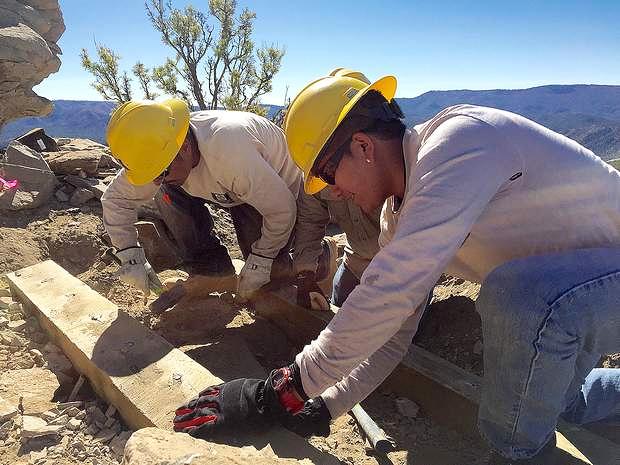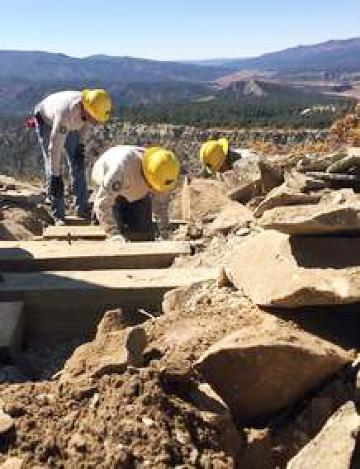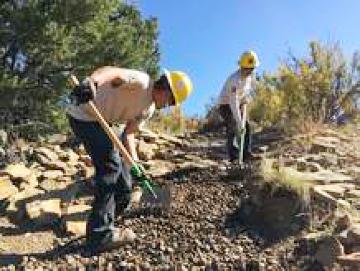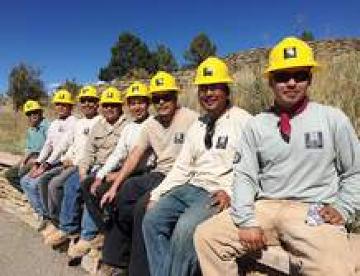 |
Canku Ota
|
 |
|
(Many Paths)
|
||
|
An Online Newsletter
Celebrating Native America
|
||
|
November 2016 - Volume
14 Number 11
|
||
|
|
||
|
Zuni Crew Preserves
Ancestor's Legacy
|
||
|
by Ann Bond - Special
to the Durango Herald
|
||
|
At Chimney Rock,
trail work protects sacred site
PAGOSA SPRINGS – Visitors to Chimney Rock National Monument next year will have a safer hike to the mesa top following work completed this month by a Native American crew from Zuni Pueblo, a New Mexico tribe with cultural ties to the ancestral Puebloans. Chimney Rock, which became a national monument in 2012, covers 7 square miles of the San Juan National Forest and features hundreds of prehistoric pit houses and ceremonial buildings built by the ancestral Puebloans. The trail to the Chacoan-style Great House Pueblo on the mesa at 7,000 feet may only be a half-mile long, but it's steep and rocky. Eight young Zuni tribal members worked for four weeks to upgrade the trail at Chimney Rock under the Southwest Conservation Corps Ancestral Lands Program. SCC established the program in 2008 at Acoma Pueblo and expanded it to include crews from the Navajo Nation and Zuni Pueblo. "This is our first year at Zuni, and we already have 45 young people in the program," said Chas Robles, SCC Ancestral Lands Program director. "We have received grass-roots support through both the native community and tribal council administration." SCC Ancestral Lands crews work across the West on historical preservation and traditional agriculture projects, stream restoration, fencing and trail construction. "We work on projects that have cultural ties with Zuni Pueblo," said crew leader Joe Peynetsa. "This work makes me appreciate the hardships of life back then, and now I can help protect where they used to live." "This is one of our sacred sites related to Zuni migration stories," said crew leader James Him. "I have heard the stories about the first people, now I get to come here to work where our ancestors built and lived." Tyler Albers, Pagosa District trail crew boss, has hired SCC crews since 2004 and was excited to have the Zuni crew at Chimney Rock because of the tribe's cultural connection. "The goal of the project was to improve visitor safety, while leaving the trail as natural as possible," Albers said. "We covered the trail surface with gravel to minimize erosion and replaced the old wooden steps to provide more stable surfaces." In addition, geotextile fabric was installed underneath to help facilitate drainage and keep gravel in place. Another important benefit was to protect archaeological resources under the trail itself. "The trail runs through the remains of nine pit house structures, so covering those with a buffer will help protect the sites from the impact of footsteps," said Lindsey Smith, Pagosa District archaeologist. The pit houses are thought to have been residential sites that were most likely occupied at the same time as the Great House, said Julie Coleman, San Juan National Forest archaeologist. "There is speculation that the last structure before the top, which we call the 'Guard House,' may have completely blocked the causeway and controlled entry to the Great House," Coleman said. Almost 12,000 people visited the national monument this summer. Volunteers with the nonprofit Chimney Rock Interpretive Association escort all visitors on guided hikes in partnership with the San Juan National Forest. Visitors come from all over the country and range from families with children to seniors. "The recent work on the steps and trail will help to create a more enjoyable and safe experience for our visitors, while protecting and preserving the archaeological sites," said Nadia Werby, CRIA marketing coordinator. Coleman said plans for next year include limited stabilization on the Great House and upgrades to parking lots, toilets and shade structures, with plans to begin development of a new visitor center and interpretative trail in the near future. In the meantime, the Forest Service has received a grant from the Colorado State Historical Fund to conduct an ethnographic study with tribes, such as Zuni, which have cultural ties to Chimney Rock. This research will help land managers better understand and incorporate Native American interests into interpretation of the site. In addition, Dr. Gerardo Gutiérrez of the University of Colorado, Boulder, recently completed Light Detection and Ranging (LiDAR) mapping at Chimney Rock. The remote sensing maps will allow the Forest Service to create three-dimensional images of the Great House to help identify previously unknown features and archaeological sites. Ann Bond is the public affairs specialist for the San Juan National Forest. She can be reached at abond@fs.fed.us.
|
|||||||||||||
|
|
|
||
|
|
||
| Canku Ota is a free Newsletter celebrating Native America, its traditions and accomplishments . We do not provide subscriber or visitor names to anyone. Some articles presented in Canku Ota may contain copyright material. We have received appropriate permissions for republishing any articles. Material appearing here is distributed without profit or monetary gain to those who have expressed an interest. This is in accordance with Title 17 U.S.C. Section 107. | ||
|
Canku Ota is a copyright ©
2000 - 2016 of Vicki Williams Barry and Paul Barry.
|
||
 |
 |
|
|
The "Canku
Ota - A Newsletter Celebrating Native America" web site and
its design is the
|
||
|
Copyright ©
1999 - 2016 of Paul C. Barry.
|
||
|
All Rights Reserved.
|
||




